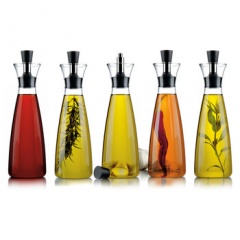Vinegar
| Infobox on Vinegar | |
|---|---|
| Example of Vinegar |  |
| Facts | |
| Origin | - |
| Stowage factor (in m3/t) | 1,56 m3/t (cases) |
| Humidity / moisture | - |
| Ventilation | - |
| Risk factors | See text |
Vinegar
Description
Vinegar is a liquid consisting mainly of Acetic acid (CH3COOH) and water. The acetic acid is produced by the fermentation of ethanol by acetic acid bacteria. Vinegar is now mainly used as a cooking ingredient, but historically, as the most easily available mild acid, it had a great variety of industrial, medical, and domestic uses, some of which (such as a general household cleanser) are still promoted today.
Commercial vinegar is produced either by fast or slow fermentation processes. In general, slow methods are used with traditional vinegars, and fermentation proceeds slowly over the course of weeks or months. The longer fermentation period allows for the accumulation of a nontoxic slime composed of acetic acid bacteria. Fast methods add mother of vinegar (i.e., bacterial culture) to the source liquid before adding air using a venturi pump system or a turbine to promote oxygenation to obtain the fastest fermentation. In fast production processes, vinegar may be produced in a period ranging from 20 hours to three days.
Application
Vinegar is commonly used in food preparation, in particular in pickling processes, vinaigrettes, and other salad dressings. It is an ingredient in sauces such as mustard, ketchup, and mayonnaise. Vinegar is sometimes used while making chutneys. It is often used as a condiment. Marinades often contain vinegar. In terms of its shelf life, vinegar's acidic nature allows it to last indefinitely without the use of refrigeration.
White vinegar is often used as a household cleaning agent. Because it is acidic, it can dissolve mineral deposits from glass, coffee makers, and other smooth surfaces. For most uses, dilution with water is recommended for safety and to avoid damaging the surfaces being cleaned.
Shipment / Storage / Risk factors
Vinegar is a brown or colourless liquid shipped in bottles or carboys. Used in the food industry, in medicine and as a latex coagulant.
Loss by leakage from holed or broken containers could also give rise to deterioration of the remainder by exposure, causing fermentation and variation of acidity.











